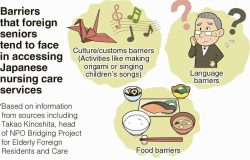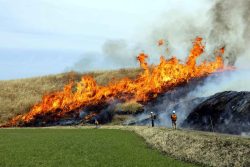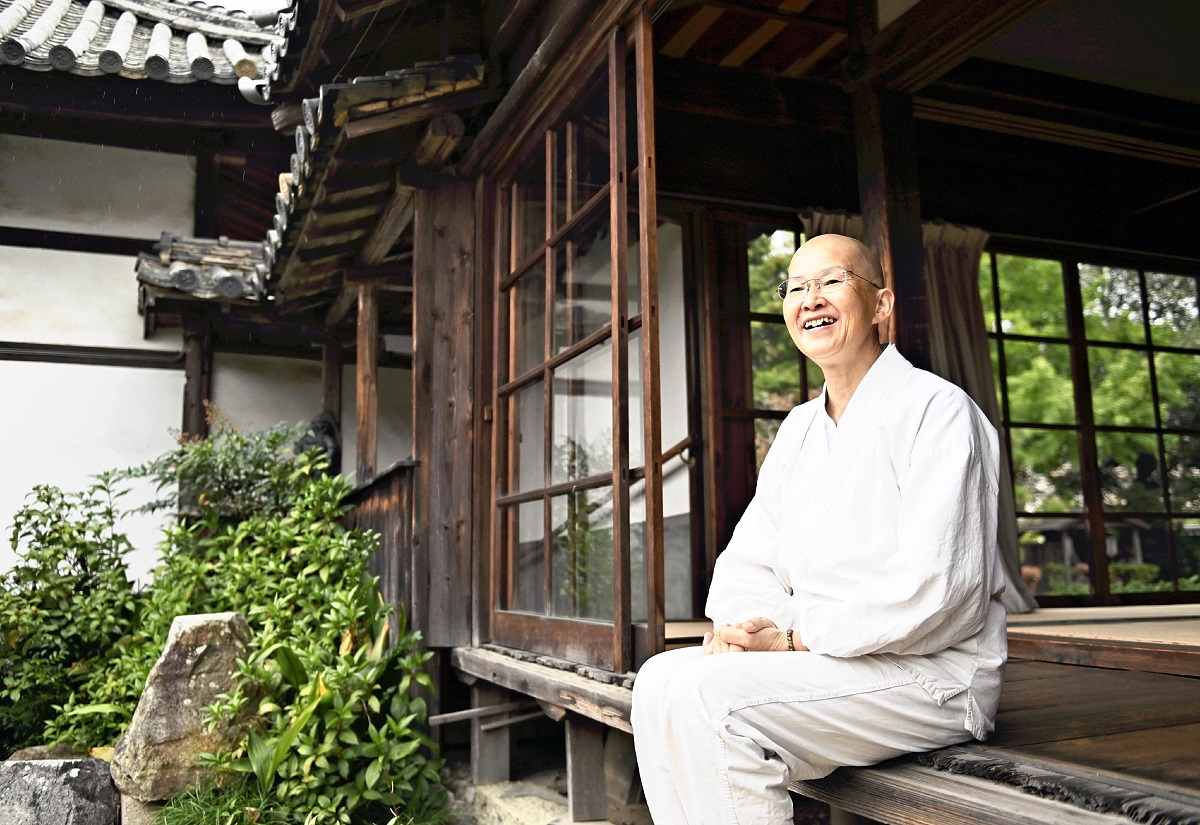
Shoki Matsuyama, the resident nun of Futetsuji temple in Himeji, Hyogo Prefecture. “If you feel lonely, come and see me. I’m always available to give advice” she said.
11:00 JST, January 11, 2024
When people become resident priests or nuns, they bring with them their experience with loneliness, emotional exhaustion, or other hardships to make their temples into a place where people with worries can come and share their deepest feelings. I recently visited two such members of the clergy to find out how we can deal with loneliness.
***
Futetsuji, a Myoshinji school Zen temple of the Rinzai Buddhist sect in Himeji, Hyogo Prefecture, was founded in the Edo period (1603-1867) by the haiku poet Den Sutejo. It is traditionally headed by a resident nun.
The current resident nun, Shoki Matsuyama, 61, entered the priesthood at 48 years old. She has been the resident nun of the temple for seven years. Known as a “refuge for suffering women,” she offers counseling and a two-day ascetic training course. Visitors affectionately call her “Anju-san,” an honorific title for resident nuns.
She describes herself as “a person who believes in her instincts and acts immediately.” She also says that she has had many setbacks in life.
After marrying while still a student, she divorced at the age of 27 and returned to her parents’ home in Fukuoka Prefecture with her two daughters. They lived with her mother and also her grandmother who had dementia. Matsuyama raised her daughters and cared for her grandmother while her mother worked in the fields. She was also a licensed assistant nurse and started to work.
Her mother and daughters were supportive, but she was “under much pressure to make a living. It was like running a long-distance race alone with no finish line in sight.”
She wanted to do something for herself. She also began to study thanatology, which is the study of the phenomena of death and the psychological mechanisms for coping with it, to support terminally ill patients. She also experienced work in end-of-life care in a hospice.
But she was exhausted. She was hospitalized with a respiratory illness and her condition worsened. Aware of death, she cried out in her mind: “I don’t want to die!”
“I could do nothing but cling to life and struggle. I learned to help people cope with death, but it wasn’t helping me at all,” Matsuyama said.
She managed to recover, became a registered nurse, and got a job in an elder care facility. The turning point for her came when she started attending a Zen meditation session.
During meditation, she closed her eyes and breathed slowly, keeping aware of her body. She felt as if the worries that had been swirling around in her mind were gradually sinking to the bottom of her stomach. “I started to feel like I was really alive,” she said, remembering that time.
She felt that she had been temporarily freed from her worries and her mind was reset. She decided to learn the technique and pass it on to others who were suffering.
After her daughters grew up and her grandmother had passed away, alleviating her family responsibilities, she became a Buddhist nun in her 40s.
At first, no one came to her temple, but she made the rounds in the local community to meet people and posted her Dharma talk every morning on a social media site. After that she began to receive more and more people.
People come to her temple and say things like: “Why am I the only one having such a hard time?” and “I’ve felt empty ever since my partner died.” She listens carefully to each visitor and tells them, “Even if things are difficult now, you are still breathing. That means your heart is working hard to keep you alive. Stop thinking for a while and instead try to feel that ‘I’m happy just being alive right now.’”
“You feel lonely when you compare yourself with others or when you think that someone doesn’t understand you,” Matsuyama said. “I want you to recognize your way of life and your own efforts. Use your loneliness as a strength to help you live as you are.”


Top: Visitors are served a bowl of matcha tea prepared by Matsuyama.
Bottom: One of the photos of Matsuyama’s daily life posted on a social media site shows her holding a cat she takes care of.
Transgender Buddhist nun provides solace to minorities
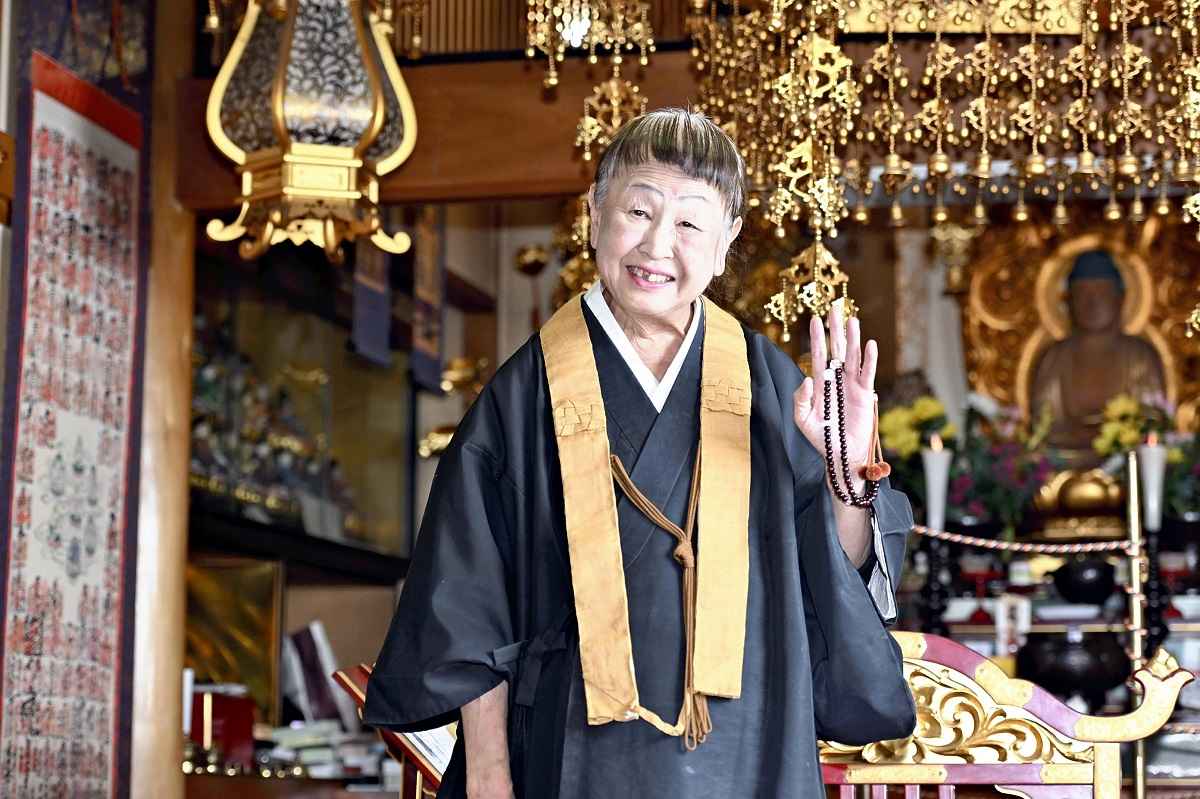
Shozenji Temple chief nun Soshuku Shibatani
Soshuku Shibatani, 69, has been offering consultations to members of sexual minorities about their worries since 2018 as the chief nun of Shozenji temple in Moriguchi, Osaka Prefecture.
Shibatani herself was assigned male at birth, felt her gender identity did not correspond and transitioned. She became a monk of the Koyasan Shingon sect of Buddhism at 51 and underwent gender-affirming surgery when she was 56.
“It was hard to live my life pretending to be someone I’m not,” Shibatani said. She said she was severely scolded by her father when she was young for secretly wearing girls’ clothes. She felt out of place both at home and school. While she wanted to be romantically involved with a man as a woman, they saw her only as a man.
Shibatani became a newspaper reporter because she felt she was suited to a job where she could meet people and listen to their stories. She thought a time may come when the struggles of sexual minorities were covered in an article. However, she was again obliged to suppress herself and live “like a man,” by having her hair cut short and dressing in a suit and tie.
In 1995, the home where she lived by herself in Kobe was completely destroyed in the Great Hanshin Earthquake, but she was safe because she was at her parents’ house the day the quake struck. While searching through the rubble of her house, she found a notebook in which she collected goshuin red ink stamps at temples — associated with the Buddhist monk Kukai — along the famed Shikoku 88 temple pilgrimage route.
Shibatani said she believed the notebook protected her from the quake. She went on the pilgrimage route again and felt as if she became free. “The attire for pilgrims is unisex. Even when I openly talked about my worries, my fellow pilgrims just accepted me as a like-minded person,” she said.
She studied at the graduate school of Koyasan University and took early retirement from her company to become a licensed Buddhist monk. She then underwent gender-affirming surgery. Shibatani said the joy of “finally being able to live as I am” was greater than the physical pain of the surgery on her body.
After she came out as transgender and started working toward opening a temple for sexual minorities, she received donations from people who were struggling with their sexuality and fellow pilgrims. “I was so grateful,” she recalled.
Shozenji temple provides consultation services and holds monthly get-togethers where visitors are served “jushoku (chief-priest) curry.”
Meeting participants have come to also include the elderly and people with disabilities, and they share their problems with each other. Some people would talk about the sadness at not being understood by their families or the prejudice and bullying they receive at school or work. Others discuss their fears of ending up alone in the future as they cannot legally marry their partners.
“People have different ways of living and worries, but, by transcending differences, we can find a way to support each other. I would like to help people do so,” Shibatani said.
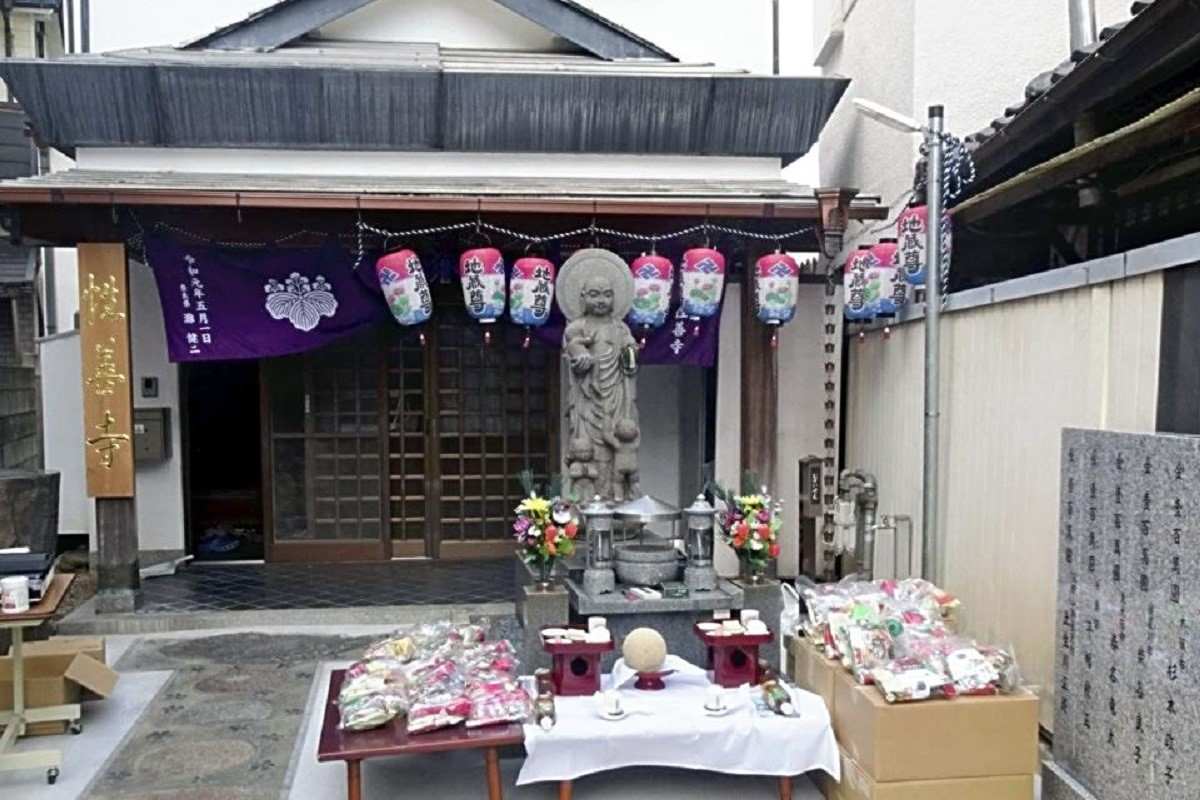
A jizo stone statue welcomes visitors at Shozenji Temple in Moriguchi, Osaka Prefecture.
Bridging the gap
Temples are increasing efforts to reach out to their communities because the custom of people supporting temples as Buddhist parishioners is diminishing in some areas as the number of nuclear families and single people increases.
The Tokyo-based Jodo Shu Tomoiki Foundation subsidizes and introduces the activities of temples and priests on its website. This fiscal year, the foundation has supported 73 projects, including organizing a rakugo storytelling event and an exchange cafe for people involved in nursing care.
Approximately 800 temples and organizations explain their activities on the website “Ikitsuke no Otera o Tsukuro” (Let’s have temples you patronize) run by the Nichiren sect.
Terakoya Buddha, a general incorporated association in Tokyo, operates a platform that supports various projects, transcending sectarian boundaries. The members of about 70 temples plan projects with companies, schools, nonprofit organizations and other entities, and seek donations for the projects on the association’s platform. The platform also runs the popular “Healthy Temple” events which consist of priests from various regions holding sermons as well as sessions of stretching exercises and meditation online every morning at 7 a.m.
“We would like to contribute to community development by making temples into warm places where people can feel free to attend, even alone,” said Kazunori Matsumura, representative director of Terakoya Buddha.
"JN Specialities" POPULAR ARTICLE
-

The Japan News / Weekly Edition (12/12-12/18)
-

English-language Kabuki, Kyogen Entertain Audiences in Tokyo; Portland State University Professor Emeritus, Graduates Perform
-

Noodle Dining Shunsai / Rich Oyster Ramen to Savor at Odasaga; Experienced 68-year-old Owner Creates Numerous Ramen Varieties
-

The Japan News / Weekly Edition (12/5-12/11)
-

People Keep Loved Ones’ Ashes Close in Special Jewelry, Small Urns as Unique Way to Memorialize Them
JN ACCESS RANKING
-

Keidanren Chairman Yoshinobu Tsutsui Visits Kashiwazaki-Kariwa Nuclear Power Plant; Inspects New Emergency Safety System
-

Imports of Rare Earths from China Facing Delays, May Be Caused by Deterioration of Japan-China Relations
-

University of Tokyo Professor Discusses Japanese Economic Security in Interview Ahead of Forum
-

Japan Pulls out of Vietnam Nuclear Project, Complicating Hanoi’s Power Plans
-

Govt Aims to Expand NISA Program Lineup, Abolish Age Restriction



